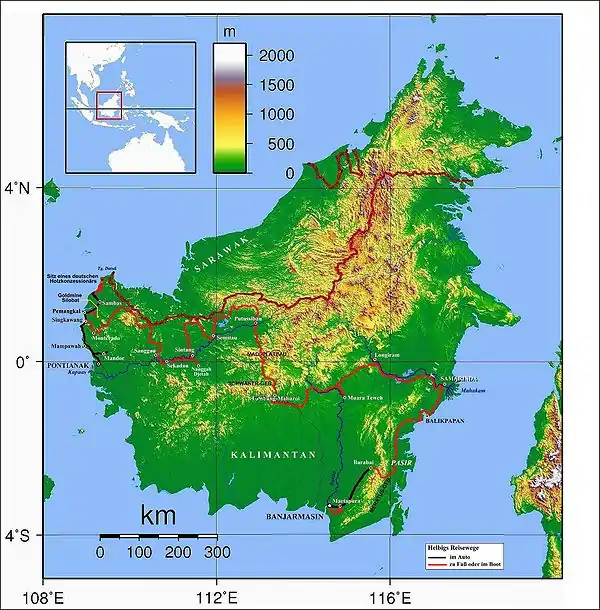Phalaenopsis gigantea
Phalaenopsis gigantea is a species of orchid endemic to the island of Borneo and was first described in 1909.[1] The specific epithet gigantea refers to the giant size of its leaves, which can grown over 60 cm in length on a mature plant. It is the largest known Phalaenopsis species.[2]
| Phalaenopsis gigantea | |
|---|---|
 | |
| Flower of Phalaenopsis gigantea | |
| Scientific classification | |
| Kingdom: | Plantae |
| Clade: | Tracheophytes |
| Clade: | Angiosperms |
| Clade: | Monocots |
| Order: | Asparagales |
| Family: | Orchidaceae |
| Subfamily: | Epidendroideae |
| Genus: | Phalaenopsis |
| Species: | P. gigantea |
| Binomial name | |
| Phalaenopsis gigantea | |
 | |
| distribution of Phalaenopsis gigantea | |
| Synonyms[1] | |
| |
Species description


- A very short monopodial stem with 5-6 large silvery-green pendent leaves that can measure over 60 cm in length
- flowers are ~5 cm across (up to 6.5 cm), cream background with raised red-brown spots, and varying degrees of green around the column, waxy
- Mature, specimen-size plants are capable of producing hundreds of flowers on pendent, branching inflorescences reaching 40 centimeters
- blooms have sweetly fragrant citrus scent
- flowers can last many months
- inflorescence can rebloom over many seasons [3]
- Although widespread belief that this orchid takes anywhere from 8 to 12 years for a seedling to reach flowering size, it may be possible to flower seedlings in 4 years with ideal culture [4]
Taxonomy
This species is a member of the species complex involving Phalaenopsis kapuasensis, Phalaenopsis rundumensis and Phalaenopsis doweryensis.[5]
Species variants
- Phal. gigantea var aurea: has a brighter yellow background color throughout the sepals and petals [2]
Growing conditions
- warm to hot growing orchid[3]
- although not difficult to grow, (gigantea) seedlings take significantly longer to reach maturity than other species
- particularly susceptible to rot if water gets trapped between the leaves
- allow potting media to dry out completely between watering
- Phal. gigantea needs its entire root system to keep the large leaves hydrated, so as a result is very sensitive to getting its roots disrupted
- prefers higher light than most phalaenopsis[2]
Use in horticulture
This plant has been used in the creation of Phalaenopsis hybrids, as its huge size and pendent inflorescences are recessive traits in crosses with complex tetraploid hybrids. Two colour morphs are significant to horticulture: paler brown patterns without red colouration against a yellow ground colour and secondly brown-red patterns against a yellow ground colour.[6] As of February 2022, the International Orchid Register of the Royal Horticultural Society lists 321 registered hybrids involving this species.
References
- "Phalaenopsis gigantea J.J.Sm". Plants of the World Online. Royal Botanic Gardens, Kew. Retrieved 11 June 2022.
- Peter Lin, Phalaenopsis Gigantea: Giant of the Genus IPA Journal - Phalaenopsis - Winter 2003 issue
- IOSPE
- Phalaenopsis gigantea (J.J.Smith 1909) Accessed 10/15/2012
- Metusala, D. (2017). "Phalaenopsis kapuasensis (Orchidaceae), a new species from Kalimantan, Indonesian Borneo." Jurnal Pro-Life, 4(3), 386-391.
- Christenson, E. A. (2001). Phalaenopsis: a monograph. Timber Press (OR).
External links
 Media related to Phalaenopsis gigantea at Wikimedia Commons
Media related to Phalaenopsis gigantea at Wikimedia Commons Data related to Phalaenopsis gigantea at Wikispecies
Data related to Phalaenopsis gigantea at Wikispecies